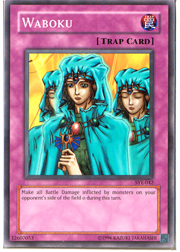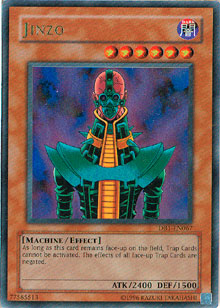
Continuing our discussion of older cards from previous weeks, we turn our focus to two cards recently reprinted in the Invincible Fortress Structure Deck: Waboku and Ultimate Offering. Both feature updated text that better explains how each card works, giving something special to players old and new. Both also have quite a tale to tell. Their respective histories have long been fraught with misconception and disagreement. We’ve come through it all with a better understanding of how they work and an earned appreciation of what they offer. This week and next, we will take a look at both cards and sort out how they function in a duel.
This week belongs to . . .
 When Waboku was first released, it was often a source of great confusion. I’ve lost count of the number of times I’ve explained its rules to new and older players alike. It never surprised me that it was so confusing, because it focuses on functions of the game that few players really understand.
When Waboku was first released, it was often a source of great confusion. I’ve lost count of the number of times I’ve explained its rules to new and older players alike. It never surprised me that it was so confusing, because it focuses on functions of the game that few players really understand.
Over time we developed a solid definition of how Waboku worked, and its text was altered twice, settling upon the current text used in the Invincible Fortress Structure Deck:
“You take no Battle Damage this turn. Your monsters cannot be destroyed as a result of battle this turn.”
Your monsters are given the sort of protection Spirit Reaper enjoys, but without that pesky “destroyed by being targeted” downside. It also keeps your life points safe from harm in battle, so monsters with effects that trigger on inflicting battle damage, like Don Zaloog and Airknight Parshath, are out of luck. In the current environment, this one card can also provide a counter to the fear and loathing that ensues from Mobius the Frost Monarch laying waste to your spells and traps.
Chain is the Game
Waboku is a highly chainable trap card, meaning you can use it in response to many, many card effects. It has no specific activation requirements, so you can basically use it any time you like, as long as you don’t try to use it during the damage step.
Like the example of Mobius the Frost Monarch, just about every card effect that tries to destroy your Waboku can be countered with that very same Waboku. When Breaker the Magical Warrior tries to “break it,” Mystical Space Typhoon tries to “space it,” or Dust Tornado tries to “dust it,” you can respond in a chain and make your opponent waste a card. His or her ability to harm you is also neutered by Waboku’s effect. Things really don’t work out well for the opponent at all.
Still an Attack
One thing Waboku won’t do is stop the attack outright. For most monsters, this isn’t a problem, but when you have defending face-down monsters, they will still react to the attack. The defending face-down monster will flip, and if it has a flip effect, that effect will activate. This works great for monsters that need to survive battle to get the most of their flip effect, like the elemental charmers from The Lost Millennium.
Then we have the goblins—Goblin Attack Force and Goblin Elite Attack Force—and monsters like Spear Dragon, that switch into defense position if they attack. Normally if you can stop these monsters from attacking (by using a card like Gravity Bind or Magic Cylinder), the monster will remain in attack position. Waboku doesn’t stop the attack, however, so the attacking goblin or Spear Dragon will shift into defense position and be left vulnerable during the next turn.
Offense and Defense
Waboku’s normal intended use is defensive. You use it to prevent your opponent from harming your monsters and life points in battle. But back when the card was first released, players handled this concept differently. Some players thought it lowered the ATK of their opponents’ monsters, so they would naturally destroy the attacking monster when it battled with one of their own. Others thought that the battle stopped entirely and that even if their monster was stronger, nothing would happen to either one. Both of these concepts were wrong, and our card rulings clarified the matter.
At some point a rumor began to spread that Waboku would protect both players. I really don’t know how or where this one got started and it certainly wasn’t supported by any of our card rulings at the time. Waboku will only protect the player who activates it, as well as his or her monsters. The opponent’s monsters are completely out of luck.
For example, if my opponent uses his or her D. D. Assailant to ram into my attack position Giga Gagagigo, using Waboku won’t help me to stop what’s coming. My opponent’s D. D. Assailant is going to be wiped out, and when it goes down, it’s taking my Giga Gagagigo with it. Waboku will only protect my monsters from being destroyed in battle. My opponent’s monster is toast.
This realization led to an interesting use for Waboku: an offensive weapon. Back in the early days of the Yu-Gi-Oh! TCG, when it was common to see a field of 1800 ATK monsters engaging in battle, a card like Waboku could help beat the stalemate. When monsters with equal ATK values engage in battle, they are normally both destroyed. Waboku changes this, protecting one of the monsters in battle but not the other. The player protected by Waboku can take advantage of this and ram monsters head-first into his or her opponent, then come out of the battle unscathed.
We ran into an interesting situation when two monsters with 0 ATK each went head-to-head. For a time there was some debate among players that Waboku would reduce the damage to 0, and 0 also happened to be the ATK of each monster. Was someone going to the graveyard?
Allowing the protected monster to be destroyed in battle was never the intention of Waboku. The new text does a good job of expressing this in clearer terms. We know that the ATK of the protected monster doesn’t matter, because it is protected from destruction in battle. The other monster with 0 ATK is toast.
 Jinzo and Waboku have had a sordid history ever since they first matched wits in the epic battle of Pharaoh’s Servant. The victor in their great war was normally the one that struck first.
Jinzo and Waboku have had a sordid history ever since they first matched wits in the epic battle of Pharaoh’s Servant. The victor in their great war was normally the one that struck first.
If Waboku was activated before Jinzo was summoned, it would apply its effect and could no longer be stopped by Jinzo. Even if Jinzo was summoned to the field later in that same turn, it would have no effect on the Waboku that had already resolved. If Jinzo was summoned first, it would apply its effect and prevent Waboku from being activated at all.
Around this time, many players tried to use Trap Hole and Waboku against Jinzo, but it wasn’t possible to use either one. After Jinzo hit the field, it was far too late to respond with traps. Back then, I had players who knew this, so they would try to interrupt the tribute summon with Waboku. This was also incorrect: you cannot interrupt a player during the middle of a tribute summon. He or she removes the monster(s) from the field and then places the new monster onto the field, at which point you can then respond to the summon. That’s where Jinzo would make its presence known, preventing pretty much every trap card from having any more say in the matter.
Check back next week as we conclude our look into classic cards with Ultimate Offering. Until then, send all comments and questions to Curtis@Metagame.com